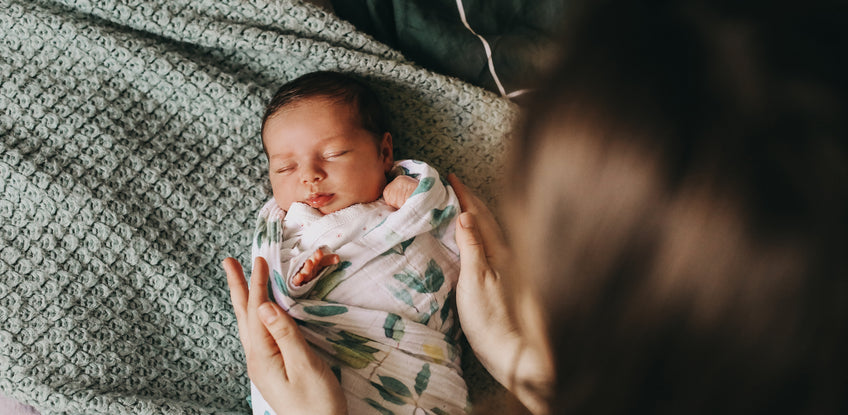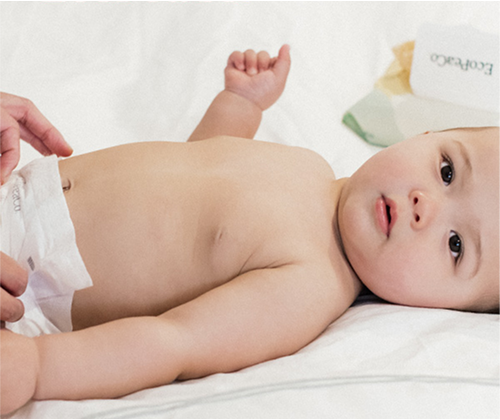Did you know a baby can result in an average of 58.6 tones of CO2-equivalent emissions in one year? That’s right, according to a study done by Lund University in Sweden (source) the products that a baby requires can have a serious impact on the environment. This isn’t too surprising when you really think about, as babies require an abundance of care products and special gear. That equals a lot of consumption in just the first year of life. But don’t worry, we’ll get to how to reduce a baby’s carbon footprint.
For now, here’s more insight on the environmental impact of a baby.
- A baby uses about 2,500 diapers, and around 3,000 baby wipes, in one year. And it takes the average diaper 500 years to decompose, and a baby wipe 100 years.
- Baby food pouches are typically not recyclable and can take hundreds of years to decompose.
- More than 20 billion pounds of clothing is thrown away every year. Much of this is children’s clothing, as they grow out of garments so quickly. The clothing that ends up in landfills (which is most of it) contributes to the release of greenhouse gases and can leach toxins into the soil and water supply. The same is true for the baby gear that’s thrown out when it’s no longer needed.
- The single-use plastic containers that many baby care products come in contribute to the more that 120 billion units of packaging (produced globally) from the beauty industry. Most of this packaging ends up in landfills, where it will live forever.
In addition to harmful packaging, many baby care products contain toxins that aren’t good for baby, or the water supply.
- Plastic toys can contain heavy metals that could be dangerous for a baby, and the environment. Plus, they’re often made from petroleum byproducts, which don’t do any favors for the health of the planet.
This might seem grim, but take heart that there are a number of actions parents can take to reduce their baby’s environmental impact.
What to Do
There are many ways to minimize the potentially negative influence a family may have on the environment. Making small shifts in how you shop and nurture your baby is an important first step, as it can go a long way towards healing the planet. And as an added bonus, many of these suggestions will help you save money!
- Buy biodegradable and intentionally made diapers and wipes. Purchasing diapers and wipes from brands like EcoPea that provide products made from biodegradable ingredients helps you significantly cut down on your baby’s environmental impact. Diapers and wipes made from biodegradable ingredients are such a plus because they’re able to break down and blend back into the Earth in a relatively short period of time, instead of just sitting in a landfill for hundreds of years.
- Make your own baby food. Creating your own baby food lets you control the ingredients in your baby’s meals, and provides the opportunity to store food in reusable containers, like ice cube trays. This results in a healthier child, and practically zero waste.
- Buy baby clothes second hand. Further limit your landfill contribution by purchasing your baby’s clothes from a secondhand, or consignment, shop. The clothing found in these types of stores are often in incredible condition, as babies only wear them for a few months (or even just a few weeks!) before they outgrow them.
- Buy used gear. With the exception of a crib mattress and car seat, all baby gear can be safely bought secondhand. Just like baby clothes, much of this secondhand gear will be only lightly used, as parents need the gear for such a short period of time.
- Skip many of the common skin care products. Instead of purchasing diaper cream and moisturizer that often come in single-use plastic containers, and can contain harmful ingredients, you can utilize coconut oil for moisturizer, and breast milk (or coconut oil) for diaper rashes.
For items like shampoo and sunscreen, purchase from eco-friendly brands that don’t use toxins. Click here for our guide on “How to Avoid Harmful Ingredients in Baby Products”.
- Purchase wooden, or secondhand toys. Instead of buying brand new plastic toys, you can instead opt for wooden toys from eco-conscious brands, or buy from a secondhand store. Then, when your child outgrows their toys, donate them to a friend or take them back to that secondhand store.
We’re hopeful these ideas can point you in the right direction, and help you make shifts to lessen your family’s impact on the environment. However, honor the fact that you likely have a lot going on, and know that you can take this one step at a time. Your first act can be as simple as setting up a monthly delivery of eco-conscious diapers and wipes, or taking your baby for a walk around the block, instead of going for a drive. You’ve got this.


